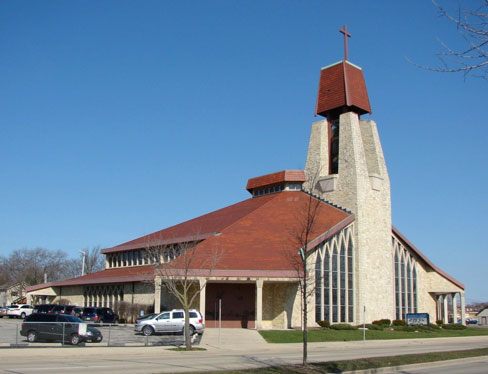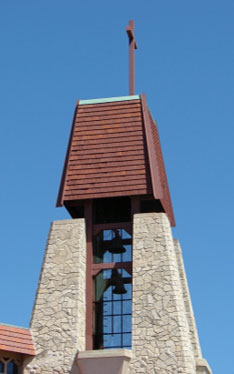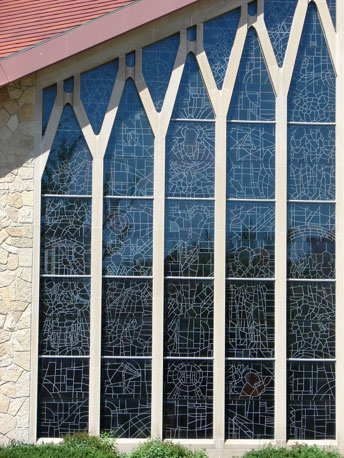66. St. Anthony of Padua Catholic, 1966
Now St. Vincent Pallotti Catholic
201 North 76th Street (at Stevenson Street)
Architects: Mark F. Pfaller Associates
St. Anthony of Padua Parish began as a mission of Holy Cross Church, located about one mile to the east on Bluemound Road. Construction of a combined church and school building commenced in 1923, and St. Anthony of Padua became an independent parish in 1925. As with several other Catholic parishes established in the 1920s, construction of a separate church was delayed by the Great Depression and World War II.
In the postwar years, development in this western portion of the city stimulated the growth of the parish and the need for a larger place of worship. Construction of the present church, with seating for just over 1,000 worshipers, began in June of 1965. The completed building was dedicated in December of 1967.
St. Anthony of Padua was one of the first Catholic churches in Milwaukee to respond architecturally to the changes in liturgy promulgated by the Second Vatican Council of 1962-65 (Vatican II). The interior is octagonal in plan, with a raised platform for the altar table projecting into the worship space. The pews are arranged around three sides of this platform to focus on the altar. This is in contrast to the standard seating plan of earlier Catholic churches, in which the pews are arranged in straight rows flanking a central aisle. The centralized seating plan of St. Anthony of Padua Church brings even the most distant parishioners closer to the clergy, and gives greater emphasis to the parishioners as a community rather than simply an audience for a ceremony.
The altar platform is located just to the west of the tower, beneath the uppermost level of clerestory windows. Two entrances on the northeast and southeast sides of the church lead into the worship space from the front, so that parishioners pass by the altar on their way to the pews. This is unusual, even for churches with centralized seating plans. More commonly, the entrance is at the opposite end of the worship space from the altar, maintaining some sense of procession from the rear of the worship space toward the altar.
The exterior walls are clad in stones of irregular shapes and sizes, arranged randomly rather than in horizontal courses. This unusual style of masonry construction is reminiscent of St. Catherine of Alexandria Catholic Church of 1920. On the interior of St. Anthony of Padua, the masonry is exposed rather than covered with plaster or other materials, but the stones are cut into rectangular shapes and laid in horizontal courses. The bell tower, with its unusual shape and shingled crown, is 100 feet in height, plus an additional 15 feet to the top of the cross. Along with the contemporary St. Veronica and St. Matthias churches, St. Anthony of Padua ushered in a new era in Catholic church design in Milwaukee, exhibiting unusual forms in addition to more centralized rather than axial plans.
In the late 1990s, St. Anthony of Padua and Holy Cross parishes merged to form St. Vincent Pallotti Parish. The parish maintains both the 1966 church and the much older Holy Cross Church, a Romanesque Revival building constructed in 1879.
Sources:
Dedication, St. Anthony of Padua Church, Milwaukee, Wisconsin, December 17, 1967. St. Anthony of Padua Church, 1967.
Pfaller, Mark F. Associates, architects. Drawings for construction of St. Anthony of Padua Catholic Church, dated September 30, 1965. Wisconsin Architectural Archive, Milwaukee Central Library, drawing set 110-19.
“St. Anthony of Padua Church Will Focus on Liturgy,” Catholic Herald Citizen, June 19, 1965, Annual Building Review supplement, unpaginated.



